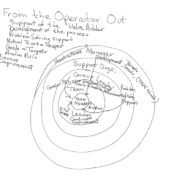The Role of HR in a Continuous Improvement Organization: Building Better Work Relations
(Reposted by permission of the author from LinkedIn)
One of the most important topics to have embedded in HR is how to build better relationships. They matter greatly and can determine the success of the entire HR organization. The connection between individuals can create energy or waste. The connection between the company and its members creates a portion of culture and is a compelling force.
There are four real costs from poor relations that must be considered from a strategic level. It is important to recognize that there is a significant cost to poor relationships at work.
The first cost is disengagement from an organization. Studies conducted by the Queens School of Business & Gallup organization found having disengaged workers resulted in much higher absenteeism, accidents and quality defects. This caused the organization to also lose productivity and profitability. In addition, these companies experienced poor share price and lower sales as a result of higher disengagement. This is a great demonstration of the power of engagement.
The second cost of disengagement came from the same study, the lack of loyalty is shown to be a significant cost. Loyalty generates a significant sense of belonging. There was a direct correlation between engagement and stress. the opposite, people who found loyalty in their work were much more likely to stay and experience the good in the relationship. As you might expect, turnover was substantially lower and productivity higher. The Center for American Progress estimates that replacing a single employee costs approximately 20% of that employee’s salary. The Wall Street Journal sets that cost at around 200%. It does not matter how large the cost is. What matters is that this loss can be avoided.
The third cost is poor productivity. The lack of engagement creates stress and poor productivity. When people are not fully utilized and not asked to solve problems, problems are seen as an inconvenience and never get the sense of urgency required.
A fourth cost is health care expenditures at high-pressure companies are nearly 50% greater than at other organizations. These costs are estimated to be over $500 billion per year in lost production to the economy. What follows is an increase in accidents and their impact on overall productivity. Most accidents are caused by a lack of attentiveness and most if not all could have been avoided. For the person doing their job, this creates a great deal of stress. As we will see, the lack of a good relationship with their leader could be recognized as a root cause for some of these problems
Well-being comes from a place significant to HR: a positive culture based on the relationship with the organization through its leaders. Positivity is an important set of behaviors and a feeling that exists based on the conditions of the organization. It can be measured, but very often in a negative culture the cultural tails are often hidden from plain sight. For HR, it must be observed regularly with a sense of urgency in solving problems that exist.
An important question is how we can create a better relationship process. These five questions point directly to the leadership of the organization:
- Are they self-aware and able to maintain self-control?
- Do they exhibit empathy at work?
- Do leaders have the emotional intelligence to demonstrate social expertise?
- Are they using their personal influence to achieve an accountable environment?
- Are they exhibiting the fore mentioned behavior consistently and are the outcomes of these creating a positive environment?
There is difficulty in measuring good relations. Some can be seen in legacy data such as suggestions, concern resolutions and levels of involvement but most are only seen in personal one-on-one interactions. The leader must be able to go to the worksite and engage members in meaningful conversations and proceed to action based on personal accountability and connection with the aim of the organization. This can be tracked using critical incidents for trends and for performance appraisal. However, care must be taken to not only use critical incidents for negative engagements but also, and more importantly, use them for molding success.
The leader will build good working relations by taking time, through personal interaction, as a means to establish mutual trust and respect. They will listen with enthusiasm and praise rather than blame. They will have a deep sense of solving problems without laying blame. These are strategic and enable leaders to connect and hold people accountable. These strategies for the Leaders and HR are based on self-awareness and self-control, the ability to show empathy at work and the ability to connect with all those involved to achieve good. The personal influence to get others to achieve beyond their own expectations are all guided by purpose and vision.
Human Resources has a significant role in creating good relations. They will take the initiative to make their expectations clear and actionable. They understand and derive their direction on asking questions and gathering data. They will monitor behavior and determine appropriate support to be given. They will support the formation of an approach to create a sense of urgency for resolving issues. They will celebrate success as it happens. HR will accumulate critical incidents and make sure the selection process and the promotion processes are delivering the correct competencies. HR will gather executive support and ensure they are all directly involved, even if it is a periodic walk-through of impacted areas. To reach a wider audience, the HR organization will create the communications plan to deliver several key messages to the entire workforce such as accountability, self-management, initiative and others.
HR has the responsibility to create the means and methods to build competencies. They recognize that the process of building skills takes time and patience to allow individuals to grow through experience. They put in place the coaching from leaders and HR to ensure the lessons being developed are supported at the workplace. The results of building competency must be reinforced and recognize always with an eye for improvement. This will be discussed in much more detail in upcoming articles.
By Identifying relationship needs, HR personnel can gather key stakeholders to set in place a strategy to build those competencies. They can monitor improvement and ensure the plan is accomplished. They can also provide coaching and mentoring training to those who will assume this responsibility.
Making time to work on relationships is a constant issue. The allocation of time is directly proportional to the clear sense of purpose. This can be gained through goals, expectations and through direct coaching of leaders. HR can also create an expectation that the routines previously identified are followed and reflected upon. From this, goals can be set and ensuing action to execute plans can be reinforced.
As the plan is completed, a show of appreciation is in order for leaders to accomplish. They will learn that the most simple responses to appreciation, saying thank you, is the most highly thought of by the members. Appreciation is a great time to recognize personal accountability not just for the big achievement but for the small things that are overwhelming in their impact. After a short period of time, the appreciation is valued by those receiving it and reflected in their performance.
The need to be positive is clearly defined for all leaders and closely watched by HR. When the opposite is found, it creates a great opportunity for HR to coach the leaders. They are coached to never blame and always provide a positive learning opportunity for those involved. They create the desire to turn failure into success and aim to sustain the positive. They always work to turn personal preference into accountability for the team, the company and support members. As a matter of process, HR will demonstrate to leaders the positive impact of working toward a constructive plan for future development. This is to keep all members open, positive and developing skills to be ready for what is coming in the future.
How
As a boss, you can foster the principles of mutual trust and respect by doing the following:
Foster social connections. Every morning at Toyota Motor Manufacturing Kentucky, all the production employees gather in their teams to stretch before the start of the shift. Most think it is loosen muscles up and indeed that is a reason. However, the primary reason is for the Group Leader and Team Leader to observe the members and determine if the can do their current assignment. During that time the Group Leader is instructed to ask them how they are doing and engage them in small talk while the are warming up. This is a major source of socialization and demonstrates that the Group Leader is concerned about their health and about their readiness to perform. The members appreciate this and in turn feel free to speak during the exchange. Why socialization is important:
- Shows concern
- Demonstrates attention to the welfare of the member
- Provides the basis for conversations that are simple and easy to participate in
- Serves as the basis of work relations as the Group Leader takes care of their members
Show empathy. It has been said many times that people want to know you care long before they care what you know. This is done by showing empathy. This is important because:
- It shows genuine concern
- It allows the human side of supervision to shine through
- The feeling of being taken care of is reflected on the company
- This role for the Group leader is not a telling role but one of listening and reflecting back with concern
- It allows the member the space to derive their accountability without being directed.
Help as often as you can. Good leaders find a way to be helpful with the member. It is a basic value not expected by the member. It reflects the following:
- A perception that the leader will be there when needed
- The leader is making observations and ask themselves, “How can I help”
- It doesn’t take the accountability away from the member
- A perception of safety
In the Toyota system experimentation is promoted. The ability to feel safe to try your ideas is encouraged and promoted. The basis of this is the safety of the member to speak to the leaders about new ideas. Group leaders are taught to encourage and help without giving the answer. By asking the members to help them to solving a problem the leader demonstrates their willingness to remain humble and accept help from everyone.. From the type of interaction positive outcomes are brought forth. The cumulative effect of this is that the leaders can expect free flow of information from the members. This improves morale and promotes the linkage between an idea and a proven suggestion. It also has the following benefits:
- It creates a safe environment
- It opens further communications
- It makes humility of the leader an important competency
- It creates the discussion about positive things and away from negative blaming and control by the leader
- It creates the opportunity for the leader to ask for help
- Provides the opening for the member to share and experiment with their ideas
Manage interactions for positive outcomes not conflict. Involves working for the common good, not personal good. It encourages stewardship.
- Stewardship is being deeply accountable for the outcomes of an organization without acting to define the purpose for others, controlling others or taking care of others.
- “We need a commitment from people when we cannot guarantee job security”
Stewardship has these benefits:
- These create harmony and common purpose
- It causes the leader to work toward stewardship
- It is eases the stress of boundaries
- It causes rumors to be minimized as information is constrained by artificial boundaries
- Avoid opinions and rumors while you are listing for actionable issues.
- It makes support non-territorial and more flexible.
- Finally, separates personal and professional relations so the facts at hand are given the most attention.
The work a leader should be doing toward creating a positive and healthy culture relationships within a team rests on these major principles. Research on the qualities of a positive workplace culture boils down to these essential characteristics:
- Caring for, being interested in and maintaining responsibility for colleagues as friends.
- Providing support for one another, including offering kindness and compassion when others are struggling
- Avoiding blame and forgive mistakes
- Inspiring one another at work
- Emphasizing the meaningfulness of the work
- Treating one another with respect, gratitude, trust and integrity.
HR as the “keepers of the culture” can make the difference to all involved. Relationships are a continually active engagement. For HR, relationships are important to coach and support. These aspects of HR are critical and each and every person has to be prepared to exhibit excellence in relationships.

 2019, Total Systems Development
2019, Total Systems Development 2019, Total Systems Development, Inc.
2019, Total Systems Development, Inc.


 Total Systems Development, Inc., 2019
Total Systems Development, Inc., 2019 2019, Total Systems Development, Inc.
2019, Total Systems Development, Inc.
 2019, Total Systems Development, Inc.
2019, Total Systems Development, Inc.